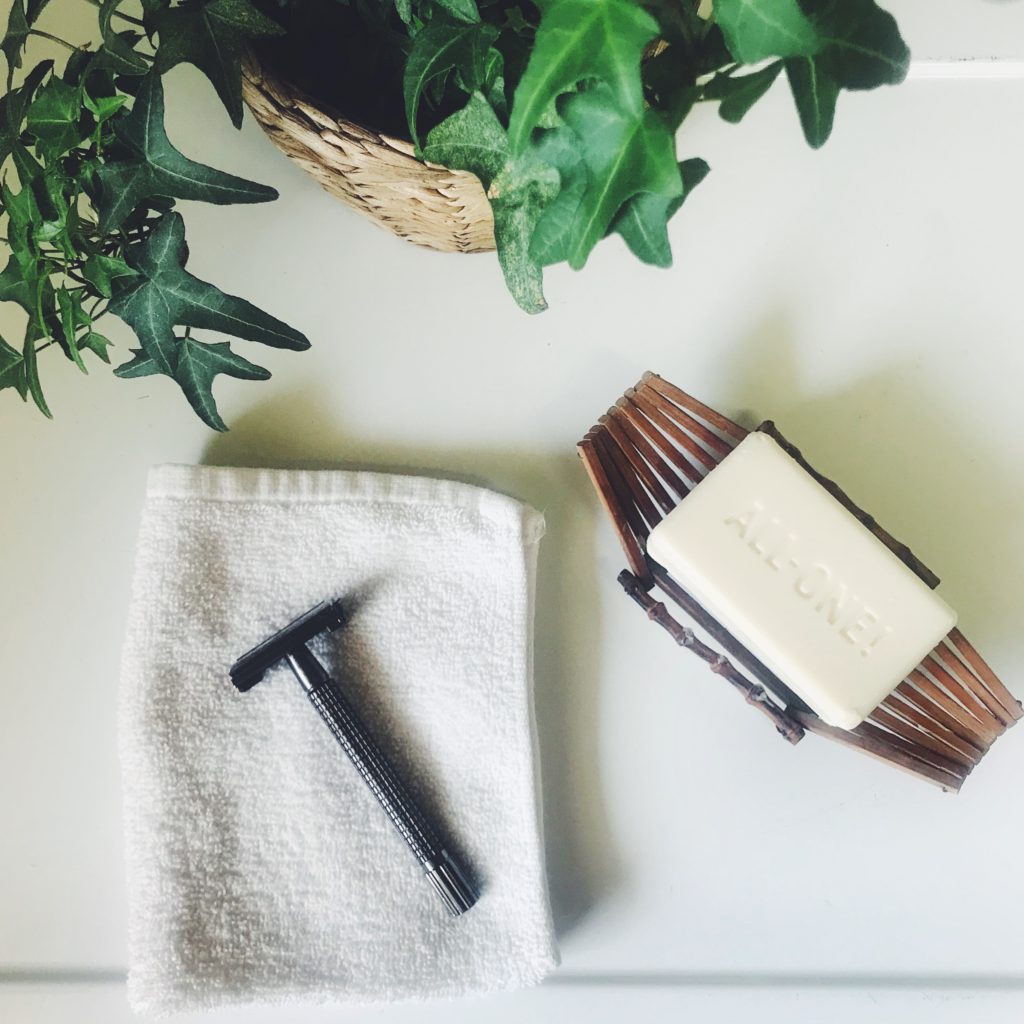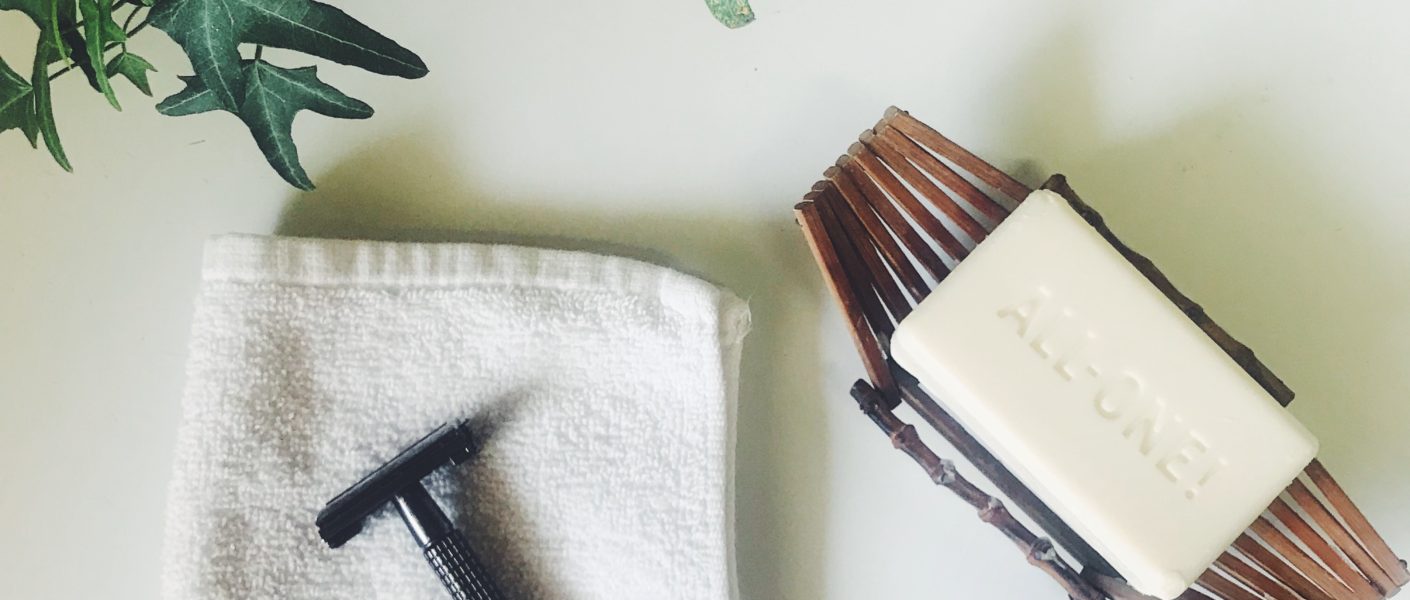I’ve finally achieved a zero waste shower routine! It’s been a long time coming; I’ve been almost zero waste in the shower for several months now. I finally started using a safety razor, making me 100% plastic-free behind that shower curtain. Although it’s just one small part of my daily routine, it’s really exciting to have gotten this area of my life down to “zero waste.”
I always emphasize that it’s all about progress in your zero waste journey. Don’t get so bogged down with all the areas you can’t make improvement in–rather, focus on the places you are improving. Keep your head up and keep on keeping on!
Sometimes that’s easier said than done. The last month I’ve found it incredibly hard to practice what I preach without getting completely burned out.
I got down on myself about all the trash coming out of our house while we hosted 3 young Japanese students in our home on base. I guilt-tripped myself about the plastic my daughter and I used on during our overseas trip back home. I winced every time I reached for another plastic-wrapped snack and milk carton with a plastic straw to pacify my screaming toddler in the convenience store of Incheon Int’l Airport, South Korea. Overseas flights with a toddler are no joke!
However, I know that some things (a lot of things) are out of my control if I still want to keep my sanity intact. I learned that “zero waste,” while an absolutely amazing achievement, is incredibly difficult when you are focusing on more than one person’s trash. I learned that doing your best is enough.
I’m pretty proud of my shower achievement, so I’m here to share it with you. It’s easy to implement, relatively self-explanatory, and will actually save you money long term. Here you go!
1. Shampoo bar
This was one of the first plastic-free changes I made when I first stumbled across the zero waste movement. It seemed like it would be an easy and straight-forward swap. I’ve been using a shampoo bar for almost a year now. Honestly, I can’t tell the difference between using a bar of shampoo vs. using liquid shampoo. Pretty much the easiest swap ever!

I use the Ethique brand. I feel great about supporting their company, since they donate 20% (yes, twenty percent!) of their profits to environmental charities, their ingredients are all sustainably sourced and vegan, I’m able to buy it locally, and it’s free from SLS (Sodium Laureth Sulfate, which I avoid due to health concerns). Take my money already!
Helpful notes:
- Make sure your shampoo bar can drain properly after use. It will get used up very quickly if it sits in a puddle of water after you wash your hair every time.
- You need less than you think you do. It might not foam up immediately, so swipe the bar a couple times and then work it into your hair. I usually only need 3-4 swipes for my whole head.
2. Apple Cider Vinegar
What’s apple cider vinegar doing in my shower? Hear me out–I’ve started using it instead of conditioner. Although I was using a conditioner bar for several months (also a great option), I ran out and didn’t have time to run out to buy another bar.
I heard about the “ACV rinse” in the zero waste community on and off, but kinda dismissed it as some hippie-dippie (I’m one to talk) solution to rinse your hair with. Maybe this rinse is used if you’re camping, living in the wilderness, don’t have access to water, or living out of a van–this are the images that were conjured up when I thought about rinsing my hair with apple cider vinegar.
But once I ran out of my conditioner bar, I figured I should Google it and give it a shot. Guess what? I haven’t gone back. Apple cider vinegar is amazing. My hair is lighter, bouncier, and feels better conditioned than ever. AND I’m saving a ton of money. A bottle of ACV: $4. A conditioner bar: $14-18.

Helpful notes:
- Recipe: 1 part ACV + 3 parts water.
- I also add 10 drops of lavender essential oil so that I smell more like flowers and less like a salad. I barely smell the vinegar at all after I get out of the shower, and the faint smell is completely gone in less than an hour. Tea tree oil is also a great option if you get dandruff or have a dry scalp.
- Use a squirt bottle so you can squirt it directly on your hair. I used a jar for awhile and a lot ended up going down the drain. I repurposed a giant agave bottle from Costco for my ACV solution and it works great.
3. Soap bar
I use the all-encompassing Dr. Bronner’s soap bar for both body wash and shaving cream. I swear, you really don’t need shaving cream! I lather the soap up and shave away. If you are still using liquid body wash, make the switch to a soap bar.

Many liquid body washes have plastic microbeads, which are in the process of being outlawed in Europe but are still widely in circulation in the States and most other parts of the world. Microbeads are awful for the water supply, for marine life, for you, for the planet. Steer clear!
Dr. Bronner’s soap does contain palm oil, but I let it slide since the palm oil is fair trade certified and sustainably sourced from Ghana, Africa. No orangutans or rainforests being destroyed for the palm oil present in this soap.
4. Washcloth
I use a washcloth instead of a plastic loofah. Pretty self-explanatory. It does the job, it’s reusable, and it’s made of natural materials instead of plastic!
5. Safety Razor
Lastly, this was the final piece of the puzzle to make my shower routine plastic-free. I had a container of Venus razors I’d been slowly using up and I finally ran out. Time to make the switch! I’ve only been using the safety razor for a little over a week now, but I love it!
It shaves much closer to the skin and has reduced any bumps or irritation I used to get. I love the shave it provides! It was a bit daunting to pick up and actually start shaving with, but I was pleasantly surprised. Not to mention the money you’ll save–you’ll only need to buy replacement razorblades, never another whole razor.

I bought the Weishi razor on Amazon (great reviews, only $17) which came with a little instructional booklet. I read through it before I shaved, and I’m glad I did. You don’t shave the same way you would with a conventional plastic razor. Here’s an article from another zero waste blogger that goes into more detail about using a safety razor.
There you have it!
I found most aspects of a plastic-free shower routine to be simple swaps that could be implemented without a second thought. The most intimidating one was definitely the safety razor, but it turned out to be much easier than I expected.
After the last month being a bit discouraging in terms of my own sustainable journey, I’m grateful to be making little baby steps of progress again and not feeling the strain of eco-burnout anymore!
Like always, I love hearing from you. Feel free to leave a comment if you have any other ideas or any questions for me!




I have made the switch to a more sustainable lifestyle, thank you for sharing these tips. These will surely lower my enviromental impact.
Good luck with your sustainable journey! Glad you found this post useful!
So many people have no knowledge of the fact that shampoos that grow your hair faster and longer (obviously with no sulfates, no parabens and no DEA) exist. Persons now may achieve longer hair and enjoy more options. Certainly worth investigating.
If you’re studying hair loss, damaged hair, avoiding skin disorders, fast hair growth, hair health normally, almost the same ideas apply.
In most cases, you will want to stay away from hair products and treatments that contain chemicals such as parabens, DEA or sulfates.
What’s good for your hair is good for your skin as well.
It goes without saying your content on this page is so accurate for many reasons. It stays away from the common traps and traps most fall into: using defective alternatives. Greatly appreciated!